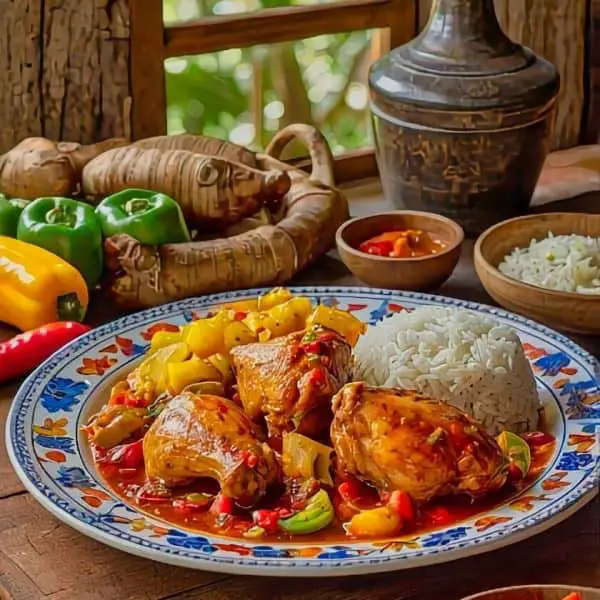Haitian Poule Creole recipe – I learned about this dish while I was in Haiti. This chicken stew possesses strong flavors and also utilizes fresh, local ingredients in true Haitian style.
In the Haitian Poule Creole recipe, drumsticks of chicken are sautéed with assorted veggies and spices. Chopped onions, crushed garlic, bell peppers and celery are cooked in olive oil. This is the base of the stew. These veggies need to be fresh because they add color and crunch and make the dish taste better.
Many of the ingredients in the Haitian Poule Creole recipe come from local farms. They’re often picked fresh out of the yard and eaten whole or cut up. This helps local farmers and makes the dish fresher and better for the environment in addition to tasting better. You may even find fresh spices like thyme, paprika, and paprika in your farmers market.
I learned that letting the chicken cook slowly with these ingredients in chicken broth enables the flavors to blend together. An entire scotch bonnet pepper is added for heat, but the spice is dialed in so the pepper gives the stew just the right amount of kick without being too spicy.
My host kept telling me how important it was to use fresh, local products. Fresh products make the food better and they keep more nutrients in it. The support of local farms and producers also keeps the local economy going. This makes meals like the Haitian Poule Creole recipe delicious and a great example of how to live sustainably.
While the stew cooked, the smell coming out of the kitchen area made everybody want to try the finished dish. Once finished, chopped parsley was added to the dish to give it a final fresh taste.
It was more than a cooking lesson on how to make the Haitian Poule Creole recipe. It was also a chance to learn exactly how crucial fresh, local food is to Haitian cooking customs. The tender chicken and rich sauce made the dish taste good and demonstrated just how traditional cooking methods could be modernized to be more environmentally friendly.
This experience taught me more about Haitian food and gave me a great story along with recipe to post on my food blog.
Ingredients For the Haitian Poule Creole recipe
Chicken Drumsticks
Olive Oil
Chopped Onion
Minced Garlic Cloves
Chopped Bell Pepper
Chopped Celery Stalk
Diced Tomatoes
Tomato Paste
Thyme
Paprika
Cumin
Salt
Black Pepper
Chicken Broth
Scotch Bonnet Pepper
Chopped Parsley
Cooking Instructions For the Haitian Poule Creole recipe
- Season the chicken with salt and pepper.
- Heat the oil in a large pot over medium-high heat. Add the chicken and cook until browned, about 5 minutes per side. Remove chicken from pot and set aside.
- Add the onion, garlic, bell pepper, and celery to the pot and cook until softened, about 5 minutes. Stir in the diced tomatoes, tomato paste, thyme, paprika, cumin, salt, and black pepper. Add the chicken broth and stir to combine.
- Return the chicken to the pot. If using, add the scotch bonnet pepper. Bring the mixture to a boil, then reduce the heat to low and let simmer for 30-40 minutes, until the chicken is cooked through and tender.
- Stir in the chopped parsley, if using.
- Serve hot with rice or plantains.
Foods Most Eaten by Haitian Locals
Haitian cuisine reflects African, French, Taino, and Spanish culinary traditions. Another staple food in Haitian households is “diri ak pwa,” or rice and beans, consisting of black, red or white beans with spices and typically meat or fish. Griot (marinated and fried pork) is a popular dish served with “banan peze,” fried plantains, and pikliz (spicy pickled vegetable slaw). This is a popular combination at gatherings and celebrations.
Another popular dish is legim, a stew of vegetables that combines spinach with chayote, eggplant along with other vegetables and is usually cooked with meat or seafood and served with rice. A comforting meal on weekends is “bouillon,” a thick soup with beef, plantains, yams and other vegetables. For breakfast, “akasan,” a warm cornmeal porridge with milk and cinnamon, is a popular breakfast option.
Street food is also a staple in Haitian cuisine, with vendors selling various snacks. Pate is a flaky pastry filled with meat, fish or vegetables that is usually eaten on the go, and fritay is a platter of fried foods that include plantains, malanga, and sometimes seafood. Soup joumou, a pumpkin soup eaten on New Year’s Day to celebrate Haitian independence, is symbolic and popular. Together these dishes reflect the diversity and richness of Haitian food culture that reflects its people’s resilience and creativity.
5 Essiential Ingredients for Haitian Food
Epis (Haitian Seasoning Base): Epis may be the main ingredient of Haitian food preparation – a vibrant blend of herbs, spices and vegetables that marinate meats and flavor stews, sauces and rice dishes. Made with garlic, scallions, bell peppers, onions, parsley, thyme and quite often Scotch bonnet peppers, epis is crucial to Haitian food. It is often made in large batches and stored for use in everyday cooking.
Scotch Bonnet Peppers: Scotch bonnet peppers are an essential ingredient in Haitian food preparation, because of their heat and fruity flavor. They are used in pikliz (a spicy pickled vegetable relish), marinades and soups. The pepper is a component of the bold flavors of Haitian food.
Plantains: A staple in Haitian cuisine, plantains are fried, boiled or mashed in various dishes. They are usually a side dish or snack. A popular dish is “Banan peze,” or twice-fried plantains, and “bouyon” may consist of plantains in a broth with meat and vegetables. Plantains provide a starchy, slightly sweet accompaniment to meals, and help temper the heat in many dishes.
Rice: Rice is a staple item in Haitian diets, often served with beans, vegetables or meats. Favorite dishes include “diri ak djon djon” (black mushroom rice) or “diri ak pwa” (rice with beans). Many traditional dishes are served on rice that absorbs the flavors of sauces and stews.
Thyme: Thyme is a common herb used in Haitian cooking, giving dishes an extremely earthy and aromatic note. It is used in epis, soups, stews, and meat marinades. Its subtle yet strong taste goes well with the strong flavors and spices of Haitian food and is an essential item in the Haitian pantry.
 FAQ For the Haitian Poule Creole recipe
FAQ For the Haitian Poule Creole recipe
Q: What is the main ingredient in the Haitian Poule Creole recipe, and how does it contribute to the dish?
A: The main ingredient in the Haitian Poule Creole recipe is chicken, which is typically marinated to infuse it with rich flavours before cooking. The chicken is often seasoned with a blend of herbs and spices, including garlic, thyme, and scotch bonnet peppers, which are essential in Haitian cuisine. This marinade not only tenderizes the meat but also enhances its taste, resulting in a vibrant and aromatic dish. Additionally, the cooking method usually involves simmering the chicken with vegetables like bell peppers, onions, and tomatoes, which creates a sauce that complements the chicken and adds further depth to the overall flavour profile.
Q: How can I make the Haitian Poule Creole recipe spicier without altering the main ingredients?
A: To make the Haitian Poule Creole recipe spicier without altering the main ingredients, you can incorporate additional scotch bonnet peppers or other hot peppers into the marinade. This allows the heat to penetrate the chicken before it is cooked, intensifying the flavour. You can also include crushed red pepper flakes or cayenne pepper to the sauce while cooking, which can enhance the overall spiciness. If you prefer a milder heat, consider adding a touch of vinegar to balance the spiciness or serving the dish with a spicy sauce on the side, giving each person the option to adjust the heat level to their liking.
Q: Can I use other proteins in the Haitian Poule Creole recipe, or is chicken essential?
A: While chicken is the traditional protein used in the Haitian Poule Creole recipe, you can certainly experiment with other proteins if desired. Options like goat or pork can provide different flavours and textures, while seafood like shrimp or fish can create a lighter variation of the dish. Keep in mind that the cooking times will vary depending on the protein used; for instance, shrimp will cook much faster than chicken, so adjustments will be necessary. Regardless of the protein choice, ensure to use similar seasoning techniques to maintain the authentic essence of the Haitian Poule Creole recipe.
Q: What side dishes pair well with the Haitian Poule Creole recipe?
A: The Haitian Poule Creole recipe pairs well with several traditional side dishes that complement its rich flavours. A popular choice is rice and beans, which soak up the sauce and add a hearty element to the meal. Fried plantains, either sweet or savoury, also make an excellent accompaniment, offering a contrast in texture and flavour. Additionally, a fresh salad with citrus dressing can help balance the richness of the dish, while bread rolls can be served to mop up the delicious sauce. Together, these sides create a well-rounded and satisfying meal.
Q: How do leftovers from the Haitian Poule Creole recipe taste, and how should they be stored?
A: Leftovers from the Haitian Poule Creole recipe tend to taste even better the next day, as the flavours have more time to meld together. The chicken absorbs the sauce, making it juicier and more flavourful, which many find appealing. To store leftovers, allow the dish to cool completely before transferring it to an airtight container, ensuring it retains its moisture and flavour. It can be kept in the refrigerator for up to three days or frozen for longer storage. When reheating, it’s best to do so gently on the stovetop or in the microwave, adding a splash of water or broth to prevent drying out.

Haitian Poule Creole
Equipment
- Large pot or Dutch oven
- Cooking spoon or spatula
- Knife and cutting board
Ingredients
- 8 chicken drumsticks
- 2 tbsp olive oil
- 1 onion, chopped
- 2 garlic cloves, minced
- 1 bell pepper, chopped
- 1 celery stalk, chopped
- 1 can (14 oz) diced tomatoes
- 2 tsp tomato paste
- 1 tsp dried thyme
- 1 tsp paprika
- 1/2 tsp cumin
- 1/2 tsp salt
- 1/4 tsp black pepper
- 2 cups chicken broth
- 1 scotch bonnet pepper (optional)
- 2 tbsp chopped parsley (optional)
Instructions
- Season the chicken with salt and pepper.
- Heat the oil in a large pot over medium-high heat. Add the chicken and cook until browned, about 5 minutes per side. Remove chicken from pot and set aside.
- Add the onion, garlic, bell pepper, and celery to the pot and cook until softened, about 5 minutes.
- Stir in the diced tomatoes, tomato paste, thyme, paprika, cumin, salt, and black pepper. Add the chicken broth and stir to combine.
- Return the chicken to the pot. If using, add the scotch bonnet pepper.
- Bring the mixture to a boil, then reduce the heat to low and let simmer for 30-40 minutes, until the chicken is cooked through and tender.
- Stir in the chopped parsley, if using.
- Serve hot with rice or plantains.




4 comments
The haitian poule creole recipe was a simple but enjoyable dish. It made for a really nice meal, and I liked how well everything worked together. A solid option for sure.
I cant believe they didnt mention the importance of marinating the chicken in citrus before cooking in the Haitian Poule Creole recipe! That step is essential for flavor – anyone else agree?
I cant believe they left out the secret ingredient for the Haitian Poule Creole recipe! Its like theyre holding back the key to unlocking the true flavors. What else are they hiding from us?
I have to say, adding pineapple to the Poule Creole recipe sounds intriguing! But does it really enhance the flavor or is it just a trendy twist? I might have to try it out to see for myself.